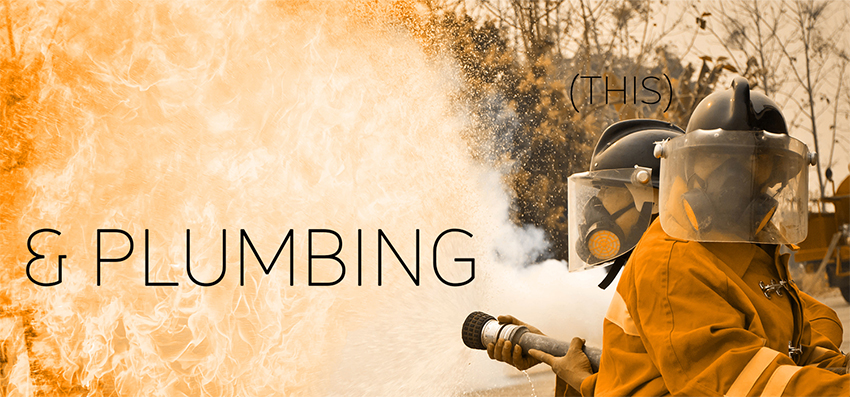[vc_row type=”standard_section” bg_position=”left top” bg_repeat=”stretch” text_color=”dark” text_align=”left” top_padding=”30″ parallax_bg=”” stellar_class=”default” section_arrow=”” video_bg=”” enable_video_color_overlay=”” video_opts=”” multi_color_overlay=””][vc_column animation=”none” bg_color=”” bg_image=”” column_padding=”no-padding” column_custompadding=”0px 0px 0px 0px” column_center=”” text_color=”dark” custom_text_color=”” text_align=”left” width=”1/1″][vc_row_inner][vc_column_inner el_class=”” animation=”none” width=”1/2″][vc_column_text]You might recall from an earlier post how 500 years ago water mains were made of hollowed out wooden logs, wrapped in steel banding. Now for a bit of firefighting trivia that came out of that era.
Did you ever wonder how the fire hydrant got to be on your street corner? Sure someone poured concrete over the city’s water main, hooking the hydrant first to that same main for some future emergency. But before that, how did we get the idea to have water strategically placed for firefighting access? Here is that story.
In the early 1800s fire fighters were armed with little more than ladders and buckets of water. It was then that they began to realize they could bore into the log water mains to get water right where the fire was happening. This made the fighting of the fire that much more effective. This went hand in hand with the invention of an engine which could draft water from the wooden water mains, doing away with the bucket brigade in 1822. After the thrilling fight with the fire, firemen would insert a plug into the wooden piping, closing off the water. This is where the term “fire plug” got its origin. Municipalities then began tapping the water mains in strategic locations on each housing block so firemen didn’t have to dig down to find the main every time there was a fire. [/vc_column_text][/vc_column_inner][vc_column_inner el_class=”” animation=”none” width=”1/2″][vc_column_text]This paved the way for the modern fire hydrant. It’s easy to forget why they are there, but while fire hydrants may have caused thousands of “gravity checks,” landing people squarely on their B-hinds, they are there to protect our homes and lives against a tragedy too great for us to realize whilst we are picking ourselves up of the sidewalk and nursing our bruised shins.
The water mains of today work in tandem with firefighters all over the country. We are thankful for our service men and for the water engineering that keeps us all safe. More than homes need plumbing. Whole cites run off of underground waterways to create the world we know and live in.
So historical wooden pipes laid the groundwork for water access to our firefighters today. We learn something new all the time. :-)[/vc_column_text][vc_column_text]Article Source:
History of Plumbing Pipes and Materials[/vc_column_text][/vc_column_inner][/vc_row_inner][/vc_column][/vc_row][vc_row type=”full_width_section” bg_image=”” bg_repeat=”stretch” parallax_bg=”” stellar_class=”default” bg_color=”” section_arrow=”” video_bg=”” enable_video_color_overlay=”” video_overlay_color=”” video_webm=”” video_mp4=”” video_ogv=”” video_image=”” text_color=”dark” custom_text_color=”” text_align=”left” top_padding=”” bottom_padding=”” class=”” row_id=”” bg_position=”left top”][vc_column animation=”none” bg_color=”” bg_image=”” column_padding=”no-padding” column_custompadding=”0px 0px 0px 0px” column_center=”” text_color=”dark” custom_text_color=”” text_align=”left” width=”1/1″][minti_callout bgcolor=”#39527f” textcolor=”#ffffff” buttontext=”Contact NIR Plumbing” url=”https://nirplumbing.com/contact-us” buttoncolor=”color-8″ target=”_self”]
We want to hear from you. Contact Us!
[/minti_callout][/vc_column][/vc_row]


